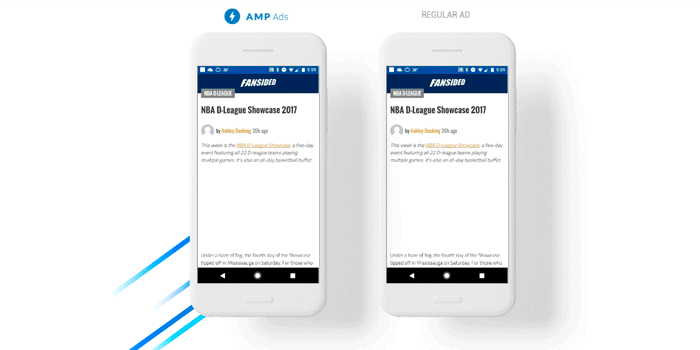Change is in the air for the display advertising industry.
Google AMP ads are gaining attention as the ads of the future.
Google also announced plans to launch a new Chrome ad-filter feature in 2018.
You might be wondering what these changes mean for your display advertising efforts and how you can continue to stay both compliant and competitive in the upcoming landscape change.
Digitaland look at what’s wrong with today’s Online banner ads before diving into AMP ads – the next generation of better, faster digital ads – and how they can help your brand stay competitive, visible and compliant with industry standards.
The problem with today’s digital ads
Many of the display ads online today are slow, disruptive and unpredictable. Unoptimized, poorly produced creative files lead to slow load times, which increase bounce rates and decrease viewability metrics.
The result? A poor online experience for users. Consumers are more likely to install ad blockers than ever before, cutting off valuable revenue for publishers and brand exposure for advertisers.
In short, today’s ads aren’t meeting campaign goals. And they’re threatening the future of the web ecosystem.
To combat the problem, the Coalition for Better Online banner ads – whose members include a variety of publishers, brands and industry bodies – has developed a list of Better Ads Standards. These are the standards Google, a Coalition member, is using in Chrome’s ad filter algorithm.
Cleaning up the web with Chrome
The new Chrome feature will block all ads on sites with certain amounts of unacceptable ads. (Google is still refining the parameters and review system. We included the ‘Do Not Use’ list below.)
It’s a controversial, but long overdue move. Despite organizations like the IAB outlining industry standards to maintain a pleasant browsing experience, too many sites are jeopardizing the free and open web with intrusive, slow-loading ad experiences.
‘Do Not Use’ list of display ads
The following ads are discouraged by the Coalition for Better Online banner ads.
- Pop-up ads
- Large sticky ads, covering at least 30% of the visible content
- Autoplay ads with sound
- Autoplay video ads with sound
- Prestitial ads, with and without countdowns
- Flashing animated ads
- Full-screen scrollover ads
It’s a robust list, meant to improve the online world and browsing experience. But forward-thinking advertisers and publishers still have a powerful tool for making the most of display ad campaigns: Google AMP ads.
What are AMP ads?
To understand AMP for ads, you need to understand the open source AMP project, launched by Google in 2015.
AMP stands for ‘accelerated mobile pages.’ And the idea behind AMP is simple: deliver a better user experience to mobile browsers.
Speed and layout are of the essence on mobile, where consumers have an even lower tolerance for lag time. AMP pages are a better way to build a content page. That means fast loading content that renders well on any device.
When Google started the AMP project, they focused on content pages. Now they’re moving to AMP for ads.
Why? At their core, ads are really about content. When they’re faster, lighter and more secure, it benefits the publisher, advertisers and readers.
AMP ads are:
- Fast-loading
- Non-intrusive
- Secure
According to Google, AMP ads can load up to five seconds faster than standard display ads. That’s a significant finding, considering most consumers will abandon a page if it takes more than a few seconds to load.
How do AMP ads work?
Google AMP ads are built with the same AMP-HTML and components that make AMP content pages lightning fast.
AMP ads are:
- 6x faster than regular ads on AMP pages
- 3x lighter than regular ads
Security is top of mind for most consumers, so boosting their confidence is the key to maintaining a free and open web. That’s why Google AMP ads are only delivered after they’ve been validated. This prevents malware. The controlled framework ensures ads always deliver the intended experience.
AMP ads are versatile. They can be delivered anywhere on the web for lightning-fast performance.
Benefits of AMP ads for publishers, brands and consumers
Speed, security and versatility make a compelling argument for AMP for ads, especially for forward-thinking digital marketers. Luckily, everyone wins when a solution is focused on building a better web ecosystem.
- Publishers: Google AMP ads are fast-loading, which means better visibility, a compelling selling point to attract advertisers and budget. A fast, secure page load also helps keep readers engaged, boosting audience numbers and viewability metrics.
- Advertisers: Brands put a lot of resources into their digital ads and they want to ensure their ads are seen. Using AMP for ads makes the most of a brand’s budget and messaging, increasing the effectiveness of campaigns.
- Consumers: Consumers are quick to abandon slow-loading pages with intrusive or irrelevant ads. AMP ads provide a faster, cleaner and more enjoyable browsing experience for the user.
While change is the only certainty in the online world, a good digital production partner can help brands and publishers stay ahead of the curve. This new era of AMP for ads promises to bring exciting changes in campaign performance, creative concepts and digital strategy.
Ready to AMP up your display advertising efforts? Drop us a line.









